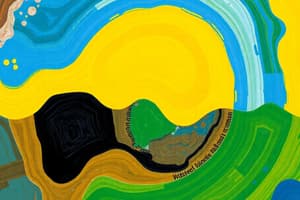Podcast
Questions and Answers
Explain the difference between cleavage and fracture in minerals.
Explain the difference between cleavage and fracture in minerals.
Cleavage is the way a mineral breaks along crystallographic structural planes, while fracture is a random pattern break.
How do metamorphic rocks form?
How do metamorphic rocks form?
Metamorphic rocks form from heat and pressure, changing the minerals and textures without melting.
How do igneous rocks form?
How do igneous rocks form?
Igneous rocks form from solidified magma or lava, with interlocking crystals.
Based on what criteria are rocks classified?
Based on what criteria are rocks classified?
How do sedimentary rocks and metamorphic rocks differ in terms of formation?
How do sedimentary rocks and metamorphic rocks differ in terms of formation?
What does the rock cycle describe?
What does the rock cycle describe?
What information do fossils provide?
What information do fossils provide?
Explain two ways in which physical weathering can occur.
Explain two ways in which physical weathering can occur.
How can ice and water contribute to the physical weathering of rocks?
How can ice and water contribute to the physical weathering of rocks?
What role do salts play in physical weathering?
What role do salts play in physical weathering?
How do glaciers contribute to the physical weathering of rocks?
How do glaciers contribute to the physical weathering of rocks?
Explain how water can contribute to the physical weathering of rocks.
Explain how water can contribute to the physical weathering of rocks.
What role does wind play in physical weathering?
What role does wind play in physical weathering?
How can plants contribute to the physical weathering of rocks?
How can plants contribute to the physical weathering of rocks?
What is chemical weathering and what does it involve?
What is chemical weathering and what does it involve?
Give an example of chemical weathering mentioned in the text.
Give an example of chemical weathering mentioned in the text.
What are the two types of processes involved in weathering?
What are the two types of processes involved in weathering?
Explain the theory of Continental Drift proposed by Alfred Wegener and the evidence he used to support it.
Explain the theory of Continental Drift proposed by Alfred Wegener and the evidence he used to support it.
Describe the process of seafloor spreading and its resulting phenomenon.
Describe the process of seafloor spreading and its resulting phenomenon.
Explain the movement of tectonic plates and the factors that contribute to it.
Explain the movement of tectonic plates and the factors that contribute to it.
Differentiate between oceanic crust and continental crust based on their composition and physical characteristics.
Differentiate between oceanic crust and continental crust based on their composition and physical characteristics.
Discuss the impact of acid rain on dolerite rock and the process involved.
Discuss the impact of acid rain on dolerite rock and the process involved.
Explain the concept of erosion and the various agents through which it occurs.
Explain the concept of erosion and the various agents through which it occurs.
How does the Mohs scale of hardness contribute to the understanding of minerals?
How does the Mohs scale of hardness contribute to the understanding of minerals?
What are the key physical properties of minerals used for identification?
What are the key physical properties of minerals used for identification?
How many known minerals are there in the Earth's crust, and how many of them form the majority of all rocks?
How many known minerals are there in the Earth's crust, and how many of them form the majority of all rocks?
Explain the roles of seafloor spreading and subduction in the creation and destruction of the Earth's crust.
Explain the roles of seafloor spreading and subduction in the creation and destruction of the Earth's crust.
Flashcards are hidden until you start studying
Study Notes
Plate Tectonics and Minerals: Key Concepts
- Acid rain can dissolve dolerite rock due to the iron in it forming rust.
- Erosion, the removal of rock particles, can occur through water, wind, and ice.
- Alfred Wegener proposed the theory of Continental Drift, suggesting Pangaea split into Laurasia and Gondwana.
- Wegener's evidence for Continental Drift included the fitting of continents like a jigsaw puzzle and the presence of fossils on distant continents.
- The Earth is composed of different layers, including the moveable lithospheric plates of the crust.
- Seafloor spreading and subduction are involved in the creation and destruction of the crust.
- Seafloor spreading results in magnetic striping due to the alignment of magnetite particles with the Earth's magnetic poles.
- The movement of tectonic plates can be explained by convection currents in the mantle and ridge push and slab pull.
- Oceanic crust is denser, thinner, and contains heavier elements, while continental crust is less dense, thicker, and contains lighter elements.
- There are 3500 known minerals in the Earth's crust, with only 20 forming 95% of all rocks.
- The physical properties of minerals include color, luster, streak, hardness, and crystal shape, which can be used for identification.
- Mohs scale of hardness, created in 1812 by Friedrich Mohs, is a standard scale used to describe a mineral's resistance to scratching.
Studying That Suits You
Use AI to generate personalized quizzes and flashcards to suit your learning preferences.




